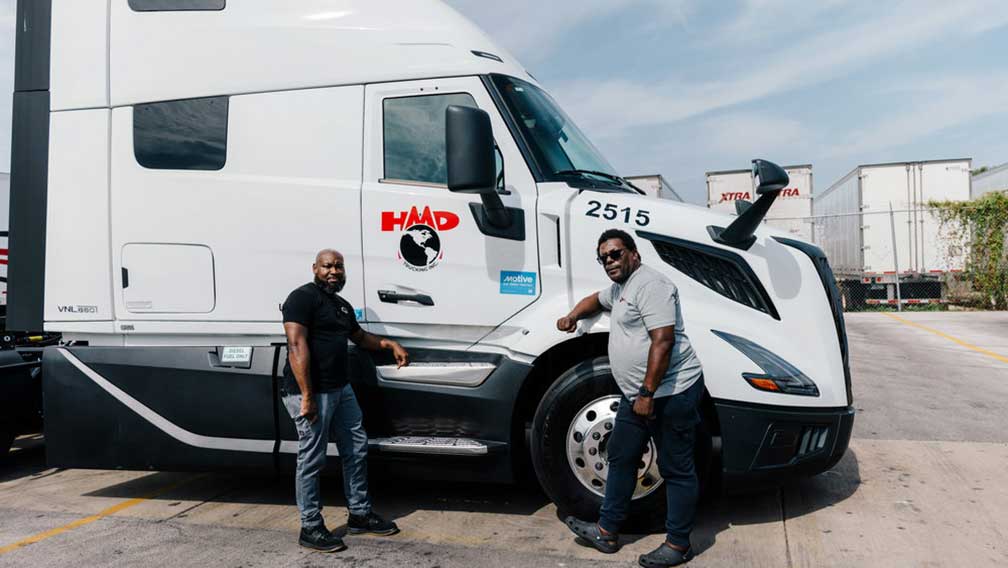Steering toward tomorrow: Navigating the future of truck driving jobs
SPONSORED BY HMD TRUCKING
The American trucking industry is running on empty. With a current truck driver shortage estimated at 80,000 — which analysts project could soar past 160,000 by 2031 — the entire supply chain is strained to its limit.
As a Chicago-based carrier, HMD Trucking keeps a close eye on industry trends, especially concerning the future of truck driving jobs. For years, autonomous trucks — Class 8 semi-trucks — were seen as a far-off futuristic threat to truck driving jobs or perhaps a savior to the capacity problem.
Today, that future is here. Fully unmanned big rigs are already hauling revenue-generating cargo on public highways in the U.S. The rise of these automated 18-wheelers sparks both interest and concern. While we want to support sustainable trucking and maximize efficiency, we recognize that the potential loss of OTR trucking jobs is deeply concerning. That’s why we initiated a deep dive into self-driving truck technology, which we present here.
The question has shifted from “Does self-driving truck technology work?” to “Can a self-driving truck’s supercomputer ever replicate the real-world judgment that comes from years of driving experience?” A seasoned truck driver can detect trouble before it arises — or talk their way out of a tough situation.
The New Class 8: Who built the truck that never blinks?
Level 4 (L4) autonomy is the only solution capable of solving the trucking industry’s profitability puzzle, as it completely eliminates the limiting factor — the human — from a specified Operational Design Domain (ODD).
This is where we currently stand in the struggle over L4 OTR semi-trucks against a backdrop of massive innovation in AI in transportation:
Aurora is the frontrunner in real-world deployment of self-driving freight, having logged commercially driverless rides in Q2 of 2025. Despite hitting that threshold, the company still has a 201 million loss related to R&D.
As CEO Chris Urmson put it, “We’re no longer selling a vision; we are selling a real product, and that’s going to change our customers’ businesses.”
Aurora scales quickly, going from one to three driverless in Q2 2025 on the Dallas to Houston route.
Daimler Truck/Torc Robotics
This team is the powerhouse OEM alliance. The “autonomous-ready Cascadia” chassis works as the basis for these trucks. Advanced redundant safety systems will be integrated. The expected release of these factory-grade L4 autonomous trucks will be geared towards the 2027 market.
A top vendor recognized for launching commercial driverless operations on private lease roads in West Texas, proving a viable early-stage “driver-as-a-service” business model.
The perfect logbook: The AI’s advantage on the open road
An L4-automated vehicle does not drive better than any good human. It drives perfectly in the sense that it is programmed to do so. That perfection translates into the tremendous economic impact of automation.
Solves the shortage, drives down cost
The trucks can drive almost 24 hours a day because there is no human behind the wheel. This proves to be useful for reducing the existing capacity shortage and optimizing the existing resources.
Autonomous trucks will replace drivers in the long-haul sector and are expected to reduce long-haul freight costs by 30%. This will save the U.S. freight industry $168 billion in annual costs. The AI in these trucks also optimizes fuel while driving. Some companies have diesel trucks or alternative fuel-powered trucks and say they save 11% on fuel in open routes.
The unblinking safety factor
Human error accounts for 85% to 94% of all truck accidents. Supercomputers will not take a break, get distracted, become drowsy or make bad decisions under stress. The safety on the highways is incalculable.
AI “watchfulness” is particularly desirable at night. With proprietary long-range LiDAR on board, the autonomous vehicles can sense objects at a distance of 450 meters and can identify and recognize people or debris on the road 11 seconds earlier than a conventional night driver in the dark.
Photo courtesy of HMD Trucking
The AI’s Achilles’ heel: Why the supercomputer can’t win
The road to mass adoption remains paved with human problems that require political will, legal consensus and public acceptance despite the technical wins. Here is where things get complicated.
The ‘patchwork’ crisis
Autonomous systems rely on precision and predictability. But the U.S. has a “patchwork” of state regulations: Thirty-five states allow some kind of testing, but the others impose conflicting, restrictive dictates.
This legal inconsistency makes cross-country autonomous freight strategically impossible at scale. The America Drives Act attempts to compel the FMCSA to establish coherent national standards by 2027, but in the meantime the fragmentation adds chaos to DOT rules.
The liability nightmare
In a traditional wreck, someone is negligently driving. But when the driverless truck that never blinks crashes, who is to blame? The liability moves from the human driver and fleet to the OEM or the software developer (product liability). This means completely redoing commercial transport insurance.
The public trust gap
The public remains deeply skeptical. A staggering 62% of Americans believe autonomous trucks will make highways more dangerous. This fear is highest among older generations, with 80% of baby boomers specifically voicing concern. This lack of trust generates political pressure that can slow progress more effectively than any technical issue.
 Photo courtesy of HMD Trucking
Photo courtesy of HMD Trucking
The human cost, the union fight and the drive for survival
The financial models driving this autonomous trend may look perfect on a spreadsheet, but they are missing the point of the tens of thousands of families that depend heavily on those long-haul paychecks.
The American truck driver is on average 54 years old, and the prospect of being informed that the high-wage, high-skill profession is being stripped down to a low-wage “truck marshal” position created truly heart-wrenching scenarios.
The union fight
The 1.3 million member-strong International Brotherhood of Teamsters is not just advocating for the reduction of “job-killing automation.” With requests like California’s AB 33, which commands the presence of a human safety operator in every autonomous vehicle, they are gearing up for battles and possible strikes for corporations.
The impossible job
What becomes of the so-called “Human Safety Operator”? Unfortunately, the picture isn’t pretty.
This operator would be locked in the cab, constantly monitoring the AI — a setup perfect for the notorious “out-of-the-loop” problem, where human reaction time slows drastically. The operator would remain bound by hours-of-service (HOS) regulations, undermining the 24/7 operational advantage that automation was supposed to provide.
In essence, the driver becomes a machine minder — reduced to surveillance duties — while industry voices suggest these “truck marshal” roles should pay at the lower end of the wage spectrum or only marginally above, disregarding the skill and responsibility once tied to actual driving.
The liability trap
The presence of a human operator in an automated semi-truck would also, theoretically, support carriers to reduce insurance rates and liability worries.
However, this “safety” option has a legal trap. If the system alerts and the operator — who may be fatigued from monitoring — fails to take over in time, the liability shifts back to human negligence. Whose fault is it when an 18-wheeler truck, automated and unmanned, is in an accident and there’s no one there to pin the blame onto?
 Photo courtesy of HMD Trucking
Photo courtesy of HMD Trucking
Ready to drive the future?
Freight still relies on professional truck drivers for the majority of the work. At HMD Trucking, we know where the real value lies right now—– with the skilled men and women in the driver’s seat.
We’ve always embraced innovation, but we also know that a driver’s skill remains the irreplaceable heart of our operation. We are a family, and you can count on a truly human attitude – not just a software update. For a deeper look at autonomous trucking and impact, check out the HMD Trucking blog on HMDTrucking.com.
If you are a professional CDL holder ready to capitalize on your irreplaceable skills, we offer:
Top pay and miles: Top-of-the-line CPMs and enough miles to guarantee a great weekly paycheck.
Reliability: Well-maintained trucks and trailers.
Life balance: Desired home time and comprehensive benefits.
If you’re ready to partner with a company that strongly relies on your human judgment, skill and hard work today, contact HMD Trucking.

The Trucker News Staff produces engaging content for not only TheTrucker.com, but also The Trucker Newspaper, which has been serving the trucking industry for more than 30 years. With a focus on drivers, the Trucker News Staff aims to provide relevant, objective content pertaining to the trucking segment of the transportation industry. The Trucker News Staff is based in Little Rock, Arkansas.
